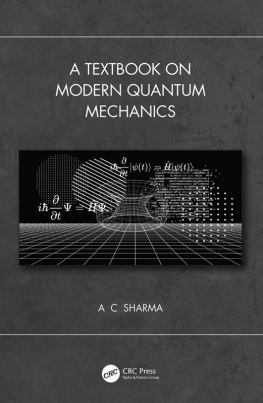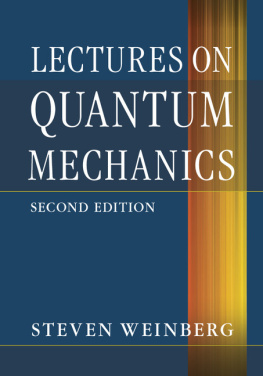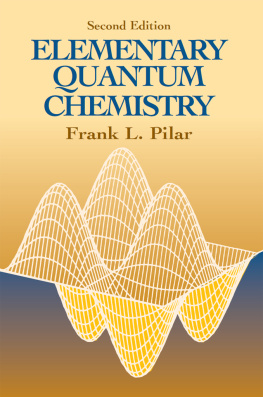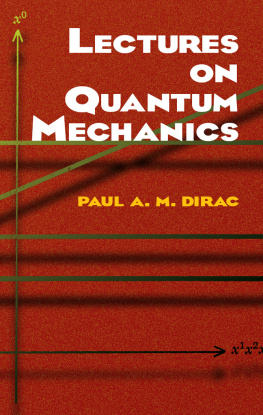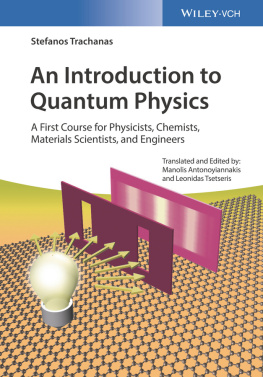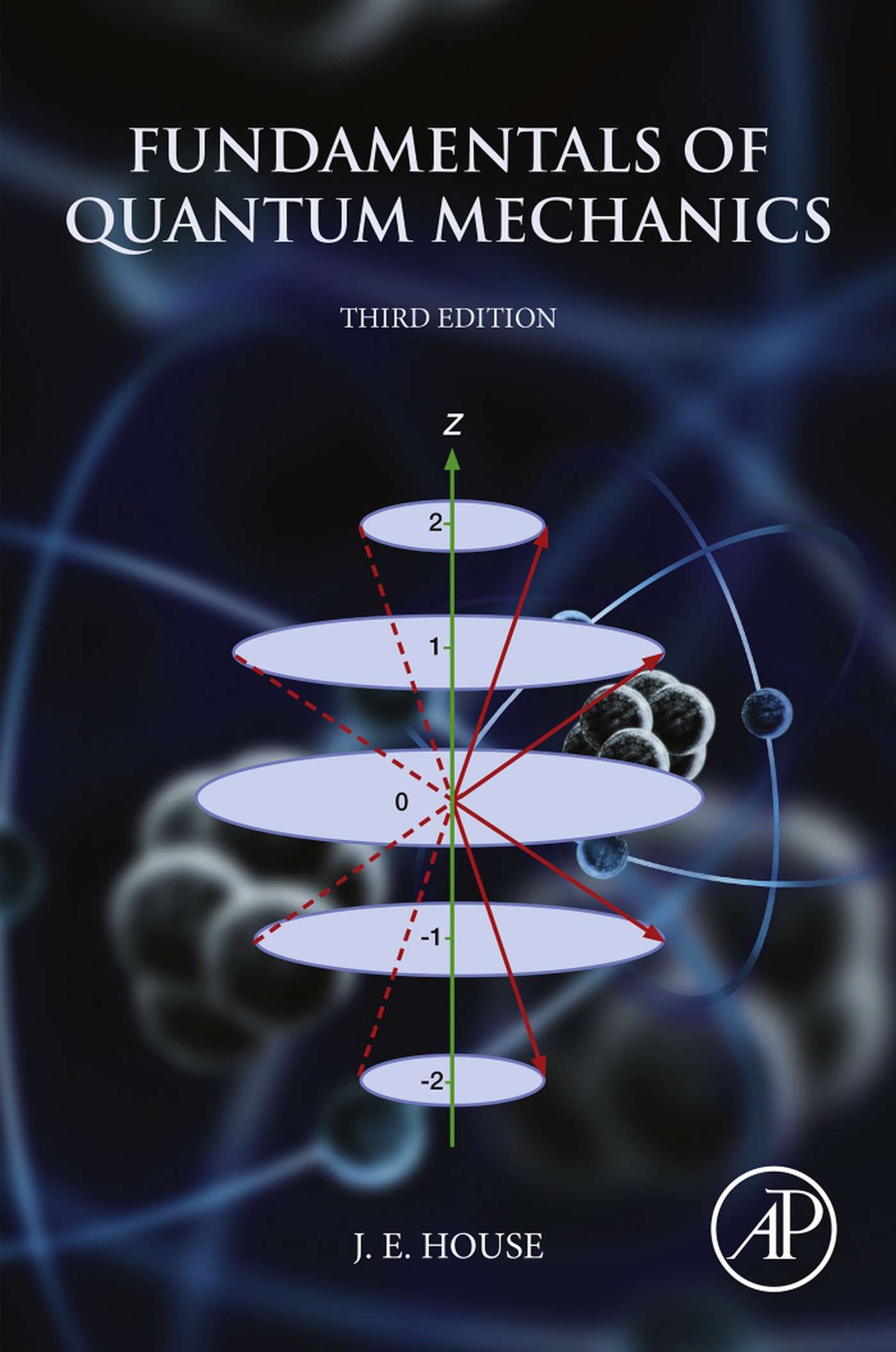Fundamentals of Quantum Mechanics
Third Edition
J.E. House
Illinois Wesleyan University and Illinois State University

Copyright
Academic Press is an imprint of Elsevier
125 London Wall, London EC2Y 5AS, United Kingdom
525 B Street, Suite 1800, San Diego, CA 92101-4495, United States
50 Hampshire Street, 5th Floor, Cambridge, MA 02139, United States
The Boulevard, Langford Lane, Kidlington, Oxford OX5 1GB, United Kingdom
2018 Elsevier Inc. All rights reserved.
No part of this publication may be reproduced or transmitted in any form or by any means, electronic or mechanical, including photocopying, recording, or any information storage and retrieval system, without permission in writing from the publisher. Details on how to seek permission, further information about the Publishers permissions policies and our arrangements with organizations such as the Copyright Clearance Center and the Copyright Licensing Agency, can be found at our website: www.elsevier.com/permissions.
This book and the individual contributions contained in it are protected under copyright by the Publisher (other than as may be noted herein).
Notices
Knowledge and best practice in this field are constantly changing. As new research and experience broaden our understanding, changes in research methods, professional practices, or medical treatment may become necessary.
Practitioners and researchers must always rely on their own experience and knowledge in evaluating and using any information, methods, compounds, or experiments described herein. In using such information or methods they should be mindful of their own safety and the safety of others, including parties for whom they have a professional responsibility.
To the fullest extent of the law, neither the Publisher nor the authors, contributors, or editors, assume any liability for any injury and/or damage to persons or property as a matter of products liability, negligence or otherwise, or from any use or operation of any methods, products, instructions, or ideas contained in the material herein.
Library of Congress Cataloging-in-Publication Data
A catalog record for this book is available from the Library of Congress
British Library Cataloguing-in-Publication Data
A catalogue record for this book is available from the British Library
ISBN: 978-0-12-809242-2
For information on all Academic Press publications visit our website at https://www.elsevier.com/books-and-journals

Publisher: John Fedor
Acquisition Editor: John Fedor
Editorial Project Manager: Amy Clark
Production Project Manager: Maria Bernard
Cover Designer: Mark Rogers
Typeset by SPi Global, India
Preface
The essential theme of this book continues that of the earlier editions. It is intended to be a presentation of several basic models in quantum mechanics and to show their application to chemical and physical systems. Throughout the development, emphasis is placed on showing sufficient mathematical details for the reader to follow the derivations. With the understanding that some readers may not have an extensive background in mathematics or perhaps may not have used some of the techniques recently, several mathematical procedures have been explained in detail. These include the solution of linear differential equations, the separation of variables, determinants, and series solution of differential equations. Such tutorials enhance the application of the book to self-study and review.
In this edition, there has been a major reordering of material so as to make what the author believes is a more logical flow of topics from the basic models to applications. Material from earlier chapters as well as several new sections have been collected in two new chapters on spectroscopy. The rationale for this change is that basic quantum mechanical models and the description of bonding in molecules are essential for interpreting various aspects of spectroscopy.
New sections appear in several chapters in order to illustrate the applications of quantum mechanics. In addition to new sections on topics in spectroscopy, others include band theory of metals, three-center bonds, and heat capacity of metals. Moreover, new problems have been included at the end of the chapters, while the practice of the second edition to include answers to some problems continues.
The appearance of the book has been improved by the inclusion of color illustrations. The majority of them have been altered or redrawn, and many additional illustrations have been included.
It is better to correct an oversight than to ignore it. Consequently, it is with deep gratitude that the author wishes to pay tribute to two professors whose efforts long ago made all editions of this book possible. The late Boris Musulin and John Eisele, through superb teaching, provided the interest in quantum mechanics that has lasted for so long. The background they gave the author provided the ability and desire to produce this book. Although both are long departed, their influence is still felt. In many ways, this book is a tribute to their success.
The author wishes to thank Academic Press/Elsevier and the editors for permission to reproduce and modify illustrations from his earlier books. Working with Amy Clark, John Fedor, and Katey Bircher has once again been a pleasurable experience, one with which the author hopes to be favored again. The loss of a computer at a most inopportune time made it necessary to retype all equations and remake almost all illustrations. Constant encouragement and understanding by these excellent editors helped to make that situation a hurdle rather than a roadblock.
Finally, the author wishes to acknowledge formally the enormous assistance of his wife, Kathleen A. House, in producing this edition. Her meticulous reading of the manuscript and numerous suggestions have been invaluable, and she has provided encouragement at all stages of the work.
Chapter 1
Origins of Quantum Theory
Abstract
Quantum theory originated from experiments involving several aspects of electromagnetic energy and matter. The study of blackbody radiation led to the idea of energy being quantized on an atomic level, which manifests itself in the line spectra of atoms. Ascribing a wave character to a moving particle led to the formulation of wave mechanics. Bohr made use of an assumption about quantized angular momentum with an explanation for the line spectrum of hydrogen. This chapter addresses several of these developments in physics that led directly to quantum mechanics.
Keywords
Electromagnetic radiation; Blackbody radiation; Waves; Line spectrum; Uncertainty principle
Quantum mechanics is a branch of science that deals with atomic and molecular properties and behavior on a microscopic scale. Although thermodynamics may be concerned with the heat capacity of a gaseous sample, quantum mechanics is concerned with the specific changes in rotational energy states of the molecules. Chemical kinetics may deal with the rate of change of one substance into another, but quantum mechanics is concerned with changes in vibrational states and structures of the reactant molecules as they are transformed. Quantum mechanics is also concerned with the spinning of atomic nuclei and the populations of atoms in an excited state. Spectroscopy is based on changes of quantized energy levels of several types. Quantum mechanics is thus seen to merge with many other areas of modern science.


